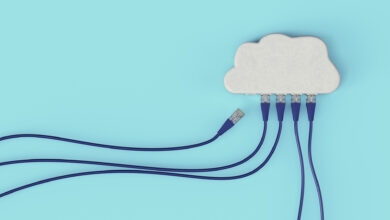How to avoid the pitfalls of implementing a digital twin.
Why data integration, conversion, scalability and a user friendly UI are core components of any successful digital replica.
The digital twin market is one of the fastest growing in tech and is set to generate a global revenue of $52,081.0 million at a CAGR of 41.3% between 2020 and 2027. As companies around the world have slowly reopened after the Covid-19 lockdown, this AI-driven technology has allowed them bounce back successfully by helping keep costs down, according to Gartner. And with a seemingly endless array of application opportunities – including rail transport, the oil and gas industry, healthcare and supply chain industries to name a few – the future is bright. But how does this virtual replica work precisely?
What is a digital twin?
In short, a digital twin is the digital representation of a real-world entity or system that spans its lifecycle. The basic concept of the digital twin finds its origins within the field of automation and is aimed at creating more transparency, enabling efficiency gains, expediting processes and making them more flexible, secure and straightforward. One might even say the digital twin is the expression of an economy slowly pivoting to facilitate the sharing of digital data. Because the life blood of the digital twin is precisely that: data, ideally real-time data. The technology can be applied to any entity or system, be it a building, a plane, a manufacturing plant, a patient, allowing businesses to make decisions enhanced by simulation, machine learning and reasoning capabilities.
The advantages of the digital twin
Users of digital twins benefit from the technology in a myriad of ways. Engineers are able to visualise their products in real time and troubleshoot far away equipment, for example. Decision-makers can create a common digital thread, connecting siloed systems, promoting transparency, while business developers benefit from being able to use predictive analytics to identify new opportunities. Holistically speaking, everyone involved in the process – in the case of a product, for example, the manufacturer and the buyer – have simultaneous access to the current product status, leading to overall efficiency gains, increased transparency and lower costs.
With 13 percent of respondents in a 2019 Gartner report claiming to already be using digital twins whilst 62 percent were either in the process of establishing the technology or planning to do so in the next year, the number of firms working with virtual replicas of their systems and devices is only increasing. So what are the challenges one needs to consider when introducing a digital double of a device or product?
The pitfalls of introducing a digital twin
As is sometimes the case with new digital ventures, implementing a digital twin is not without its challenges. A substantial amount of time, sufficient capital and skilled personnel are necessary, for one. So, if you’re looking to invest the required resources to introduce the technology within your business, you’re going to want the final product to be up to scratch. As mentioned earlier – a digital twin is defined by the value of its real-time data. Which brings us to our first pitfall.
Inability to source quality data
As a virtual image, the digital twin allows previously disparate departments across operations, maintenance, finance, sales, and marketing to access a unified source of information. However, these insights are only as valuable as the data they run off. If the data has been entered by hand or is not up to date, for example, then the digital twin will not provide a reliable basis for decision making and business projections. Ensuring the availability of consistent, accurate and real-time data is key. A good way of doing this is to work with a data integration software such as Lobster_data. It takes care of the data mapping, conversion and manipulation in record time, giving businesses the peace of mind that their data is getting where it needs to go quickly, in the necessary format and with the requisite quality.
Failing to support the necessary communication standards
Navigating the countless standards commonplace in today’s global economy presents another challenge to digital twin users. If the necessary data isn’t able to get from A to B because the IoT devices involved don’t speak the same language, this essential information is not able to be fed into the digital twin. This again, risks muddying business processes and could result in companies only working with a skewed image of the state of their system. Creating an IT landscape in which IoT devices can communicate seamlessly is a prerequisite for a successful digital twin. As previously mentioned, Lobster_data is again a great option. Middleware. Data hub. EDI converter. The powerful, all-in-one solution which replaces multiple tools and answers to many names. With all conventional industry standards and automatic format detection covered, it not only saves businesses time and money but also ensures a consistent and coherent IT setup. Which, in turn, provides the foundation for an excellent digital twin.
Rushing the process
Another mistake businesses can find themselves making when first introducing the digital twin is to try and involve all processes and all IoT devices or programs from the word go. This eagerness is understandable. A digital replica of an entire production line, supply chain or building is enticing and can provide valuable insights. However, rushing into it can result in unnecessary errors with valuable configurations and critical data being missed out along the way. Choosing one or two key pieces of equipment or systems is the ideal place to start. Once these have been perfected, new areas can be added, expanding the digital twin in the process. Businesses choosing this gradual approach are best working with a scalable solution, allowing them to upscale as and when needed. In this respect, Lobster_data is a clear winner as it works just as well on mini servers as it does on sophisticated versions within computer clusters. With a variety of licenses and delivery models available, it fits the bill perfectly.
Lack of user buy-in
The final pitfall on our list revolves around getting users to appreciate and value the importance of the digital twin to them as individuals but also to the business as a whole. After all, the digital twin requires the support of numerous stakeholders, the involvement of which being crucial for the quality of the virtual replica. Resistance or scepticism can undermine a company’s efforts and put the success of implementation at risk. One reason why users can struggle to engage with a virtual twin is a lack of confidence in working with the software involved. As digitalisation takes hold, it is becoming increasingly necessary for employees to take an active role in shaping digital solutions – a task previously reserved for IT specialists. If these users don’t feel confident in working with a solution, they’re going to resist the roll-out. Working with no-code and low-code solutions, such as Lobster_data, is a logical way to ensure optimal buy-in. The software is suitable for IT experts and newbies alike, allowing users to configure ready-made function blocks within an intuitive HTML5 interface – thus doing away with the need for programming skills.
What’s next for the digital twin?
Dating back to the 1960s, the digital twin is by no means a novel concept. However, recent advances sparking increasingly sophisticated IoT technology has laid the groundwork for the AI-driven technology to thrive. This progress combined with an abundance of computer power becoming readily available to organisations of all sizes means the possibilities of what can be done with digital twin technology is only as limited as one’s imagination.
Although a number of industries, including manufacturing, have embraced the concept and are reaping the rewards, other sectors, such as healthcare, have not experienced a comparatively rapid adoption of the technology. These fields present an opportunity for growth, particularly as “early examples of adoption are promising and set a good precedent for diverse applications,” according to Gartner. And as more companies use digital twins to build products and enhance their systems, benefitting from concepts such as Natural Language Processing (NLP), object/visual recognition, artificial intelligence and acoustic analytics, we can soon expect to see digital twins expanding and interconnecting to form entire ecosystems.
You can find more interesting articles on our blog.




